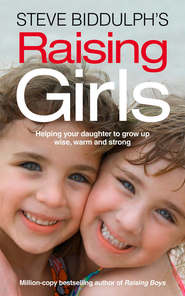По всем вопросам обращайтесь на: info@litportal.ru
(©) 2003-2024.
✖
Raising Boys: Why Boys are Different – and How to Help them Become Happy and Well-Balanced Men
Автор
Год написания книги
2019
Настройки чтения
Размер шрифта
Высота строк
Поля
PRACTICAL HELP
BOYS AND HEARING
Colin is ten. He is in trouble at school because he doesn’t pay attention. He gets bored, starts to mess around, and gets sent to the principal’s office. Is he stupid? Bad? Does he have ADHD or ODD (Oppositional Defiant Disorder) or OCD (Obsessive-Compulsive Disorder) or any of the other Ds? Perhaps, but there’s another possibility. What if he just can’t hear? What if his teacher’s voice is too soft and he gets bored with its faintness, and at home he misses half of what is being said to him? Many parents joke that their son seems deaf when told to clean up his room. And school nurses have long noted that boys get blocked ears more frequently than girls. But there may be more serious factors at play.
Psychologist Leonard Sax, in his book, Why Gender Matters,12 (#litres_trial_promo) makes some extreme claims about boys’ hearing. He presents research to show that boys do not hear as well as girls, and argues that boys need teachers who speak louder. He cites Janel Caine, a postgraduate student in Florida, who studied the effects of music on premature babies.13 (#litres_trial_promo) These babies lie in their incubators all day, and Caine felt that perhaps some gentle music might help their growth and development. And boy, was she was right! In her astonishing findings, girl babies receiving music ‘therapy’ were discharged from the hospital on average nine days sooner than those who didn’t have the music. It really perked them up! But here’s the thing: boy babies did not show any such benefit. They either didn’t hear the music, or it didn’t affect them.
It’s actually hard to know what tiny babies hear – we can’t just ask them, ‘Did you hear that?’ But lately, some methods have been discovered that can tell if the brain is receiving the message that goes into the ears. Dr Sax claims that, in studies of ‘acoustic brain response’, girl babies have an 80 per cent greater brain response to sounds than baby boys do. And guess what frequency this is in? The frequency of speech.
The difference continues into adolescence and adulthood. This might explain that terrible syndrome – complained about by teenage girls worldwide – that Dad is always yelling at them, when Dad thinks he is using a gentle voice!
In a number of recent commentaries, however, Dr Sax has been accused of exaggerating or misrepresenting the research.14 (#litres_trial_promo) And it does stand to reason that if a huge gender hearing difference was the norm, audiologists would have told us about it earlier.
Nonetheless, there is no harm in being more hearing-aware around boys. And dads, if your daughters wince when you talk to them, maybe talk a little softer.
It’s more likely that the problem of boys in school is not so much to do with hearing as with understanding. Australian audiologists Jan Pollard and Dr Kathy Rowe found that about a quarter of children aged six have poor auditory processing (separating what they hear into meaningful words). And most of these children (70 per cent) turn out to be boys. These children have trouble understanding a sentence if it has more than eight words in it! Because teachers often use much longer sentences when teaching, these kids are stuck trying to understand the first part while the teacher (or parent) is going full-steam ahead with the rest of the message. The researchers recommend that teachers use short sentences, and only go on speaking when they see that ‘lights-on’ effect in children’s eyes.15 (#litres_trial_promo) And Dr Sax adds that perhaps boys should sit at the front of the class, not the back.
PRACTICAL HELP
OVERCOMING BOYS’ TENDENCY TO ARROGANCE
It’s possible that boys are naturally prone to a certain degree of arrogance. Until recently, boys were often raised expecting to be waited on by women. In some cultures, boys are still treated like little gods. In today’s world, the result can be an obnoxious boy that no one wants to be around.
It’s therefore very important that boys are taught humility – through experiences such as having to apologise, having to do work to help others, and always having to be respectful to others. Kids have to know their place in the world, or the world will most likely teach them a harsh lesson.
Whenever you are treated badly by youngsters – jostled in the street by a skateboarder, treated rudely by a young salesperson, or have your house burgled – you are dealing with youngsters who have not been helped to fit in and be useful.
Teenagers are naturally prone to be somewhat self-absorbed, to fit their morality to their own self-interest, and to be thoughtless of others. Our job as parents is to engage them in vigorous discussions about their obligations to others, fairness, and plain right and wrong. We must reinforce some basics – ‘Be responsible. Think things through. Consider others. Think of consequences’. Just loving your kids isn’t enough, some toughness is necessary. Mothers begin this, fathers reinforce it, and elders add their weight if it still hasn’t sunk in.
One good strategy is to have boys involved in service to others – the elderly, disabled people, or young children whom they help or teach. They learn the satisfaction of service, and they grow in self-worth at the same time.
© Romrodphoto/Shutterstock.com
IN A NUTSHELL
In the years between birth and six, boys need lots of affection so they can ‘learn to love’. Talking and teaching one-to-one helps them connect to the world. The mother is usually the best person to provide this, although a father can take this part.
At about the age of six, boys show a strong interest in maleness, and the father becomes the primary parent. His interest and time become critical. The mother’s part remains important, however: she shouldn’t ‘back off’ from her son just because he is older.
From about fourteen years of age, boys need mentors – other adults who care about them personally and who help them move gradually into the larger world. Old societies provided initiation to mark this stage, and mentors were much more available.
Single mothers can raise boys well, but must search carefully for good, safe, male role models and must devote some time to self-care (since they are doing the work of two).
Chapter 3
Testosterone (#ulink_5b621285-a023-54c4-afa7-850c20a30e1f)
Janine is pregnant – seven weeks pregnant – and very excited. She doesn’t know it yet, but her baby is going to be a boy. We say ‘going to be’ because a foetus doesn’t start that way.1 (#litres_trial_promo) It may surprise you to know that all young creatures start life being female. Boys are mutated girls! The Y chromosome that makes a baby into a boy is an ‘add-on’ chromosome which starts to act in the womb – to give a boy the extra bits he needs to be a boy and to stop other bits growing. A male is a female with optional extras. That’s why everyone has nipples, though not everyone needs them.
Boys and Hormones
In Janine’s baby’s tiny body, at around the eighth week of pregnancy, the Y chromosomes stir in the cells and testosterone starts being made. As a result of this new chemical presence, the baby starts to become more of a boy, growing testicles and a penis and making other more subtle changes in his brain and body. Once the testicles are formed (by the fifteenth week), they start to make testosterone too, so he becomes progressively more and more masculine.
If Janine is very stressed, her body may suppress the testosterone in baby Jamie’s body and he may not fully develop his penis and testicles, so he will be incompletely developed at birth. He will catch up, however, in the first year.
Right after birth, young Jamie will have as much testosterone in his bloodstream as a twelve-year-old boy! He has needed all this testosterone to stimulate his body to develop male qualities in time to be born. This ‘testosterone hangover’ will result in him having little erections from time to time as a newborn.
By three months of age, the testosterone level will drop off to about a fifth of the birth level, and throughout toddlerhood the level will stay pretty low. Boy and girl toddlers (I’m sure you’d agree) behave pretty much the same.
But the effects will now have set in motion a very different trajectory of brain development that will affect Jamie until his mid-twenties at least.2 (#litres_trial_promo) The biggest change will be a slowing of his brain growth, relative to his sisters at the same age. It will make him more vulnerable in certain ways that as parents we need to know about.
In 2017, a researcher called Alan Schore released a wide-ranging review of what we know about boys’ neurological and emotional development.3 (#litres_trial_promo) Schore is held in awe by most of the child development world. He literally wrote the book on how we develop emotional wellbeing and how the brain and environment interact on a detailed, neurological level to create good mental health. His two massive tomes on the subject were the inspiration behind popular works such as Sue Gerhardt’s ground-breaking Why Love Matters.4 (#litres_trial_promo) And his new message is that we need to worry about boys much more. The testosterone effects in the womb and the first year of life slow their brain development (especially in the right hemisphere) so much that they are far more vulnerable than girls to anything that goes wrong. It sets boys up for mental health and behaviour problems much later if we don’t maximise calm, responsive, and stress-free environments for them. He included the risk of endocrine disruptors5 (#litres_trial_promo) such as BPA in our water and food supply in pregnancy, a real concern about the use of daycare in the under-ones and the risks when parents are suffering violence, stress, mental illness, addictions or financial insecurity.
Schore points out that boys are so far behind girls in their brain development that ‘the frontal cortex, caudate, and temporal lobes (the thoughtful and analytical parts of the brain) are faster growing in girls by as much as 20 months’. And ‘at ages seven to 12 boys lag behind girls by as much as two years in social sensitivity’.6 (#litres_trial_promo) That’s a heck of a delay, and means we really have to work on boys’ abilities to think through their actions, understand their feelings and those of others, and be soothed and calmed by loving affection when they are upset. And we have to not blame or shame them for not being on the same trajectory as the girls they grow up alongside. The idea of boys as rough, tough and unemotional is completely wrong. They are full of feelings, they care deeply, and they need our help to get along with others. It’s rather scary, but also hopeful – if we get this right, then the shut-down, messed-up men of today might one day be a thing of the past.
The Full-On Fours
Boys don’t just develop at a different rate to girls. They also have unique developmental stages, triggered by hormonal shifts, which are only just being understood. The full-on fours is the first of these.
At around this age, millions of parents around the world notice their boys becoming more energetic, boisterous, and hard to keep quiet. It’s not every boy, and some girls do this too, but it’s a very common and a rather challenging thing. For centuries the answer to this abundance of boy energy was a pretty terrible one. Parents would yell at boys or hit them to make them quieten down. In schools canings and other cruelties were visited on generations of youngsters (including some girls) who could just not bear to be stuck at a desk, who fidgeted or were slow to learn their 3 Rs. A good child was one who stayed quiet and still, and so boys – most of them – were bad.
Then we began to think more deeply and with a bit more compassion about what we were expecting of boys. And some science came along that appeared to help. In the 1990s Professor Mitchell Harman at the US Department of Aging described a doubling in testosterone from around 40 ng/ml to around 80 ng/ml at this very age. It was a small, and brief rise (especially when compared with the almost tenfold rise that drives puberty in the early–mid teens). I reported this as a possible explanation of the changed behaviour. Many people found this a helpful piece of information, and all over the world people became more understanding of their boys and gave them more scope to be physically active, and were more empathic while helping them learn to get along. Schools and childcare centres took steps to ensure that boys were not cooped up for too long, and built more chances for movement and activity into their day.
It was never an excuse for misbehaviour, but a message that we needed to help boys find ways to be safely active and physical. Occupational therapists added their input that at four boys are still developing their gross motor brain–muscle wiring, and so it’s more than just letting off steam. Movement is something all children need to grow their brains, but for boys that stage lasts longer.
However there was one problem – in the years that followed, the findings described by Professor Harman were not corroborated, and other endocrinologists doubted them. In fact, it was still an area that received very little study – the only study I could find began at age six, missing the four-year-old phase entirely. In subsequent editions I reported that this was a controversial finding that we could not rely on. Then some more information came to light. As is often the case with hormones, it turned out to be more complicated. What does happen at four is that boys’ bodies start to release luteinising hormone which tells their testes to start making Leydig cells, which are the little factories for testosterone which will ramp up in puberty. Luteinising hormone levels in four-year-old boys pulsate every day in exactly the way that testosterone levels do in adults, though we do not know why.7 (#litres_trial_promo) So in a sense, four is the start of the puberty process. Whether this directly or indirectly causes the behaviour changes we have no idea.
In 2017, Professor Kate Steinbeck, a specialist in children’s endocrinology at the University of Sydney, offered her explanation of the ‘full-on fours’ stage:
So, is there an alternative explanation for boys’ behaviour at this age, which parents regularly report?
1 We see differences in boys’ and girls’ brains and behaviour well before puberty. Rises in testosterone in the womb and during the mini-puberty in the first six months of life likely explain these.
2 Studies that look at behaviour in four- to five-year-olds … show boys and girls this age generally have different ways of playing and communicating. Boys’ play is generally more physical. Girls generally have more socially interactive play, and are more articulate.
3 Interestingly, girls with congenital adrenal hyperplasia, who are exposed to high levels of testosterone in the womb, tend to have more ‘rough and tumble’ play styles, consistent with a testosterone effect on early brain development.
So, how might being four or five change boys’ behaviour?
At this age, children learn how to interact with others, understand another’s needs, share, and to deal with new and unfamiliar situations. Boys may respond more physically and be less able to articulate what happened. Learning how to regulate their emotions is an important skill for children to develop. Parents can model good emotional regulation, make sure children have regular daily routines, enough time to practice play and enough sleep. Praising positive behaviour and not overreacting to minor attention-seeking misbehaviour also helps.
Persistent and distressing behaviours in a child may signal underlying anxieties, reaction to family stresses, or be a result of adversities when they were younger. So, if you are concerned, seek professional advice.
For all children, we need to prioritise time to play. That could mean space, action and permission to be noisy and boisterous.8 (#litres_trial_promo)
So, in other words, it is testosterone, but the causes are earlier in life, only coming to the fore through the stresses of being four!
There is something we need to remember here. For 99 per cent of human history, we were a very physical and lively species – we moved about all the time. In hunter-gatherer society, four-year-old boys are just leaving toddlerhood, and start rapidly acquiring the stamina, strength, and amazing physical dexterity needed for their adult lives. (I lived with and studied hunter-gatherer people in the mountains of West New Britain in the 1970s, and from the very first day I was astonished at how capable and independent small children were, often accompanying us on long journeys without any sign of fatigue. Nothing saddens me more than seeing the cooped-up tiny spaces that urban children now live in, or the way our schooling forces kids to stay sitting for long periods in the same place.)











